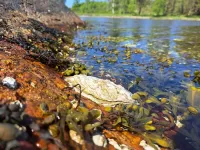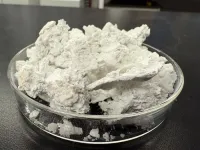Pacific oyster may colonize the Baltic Sea
2025-03-19
(Press-News.org) The invasive Pacific oyster have adapted to life in less salty seas and are reproducing off the coast of Skåne, although having been there for less than ten years. This discovery by researchers from the University of Gothenburg suggests that the oysters could colonise the western Baltic Sea in the future.
Pacific oysters were imported to oyster farms in Europe in the 1970s to replace native oysters whose stocks had collapsed. But they quickly began to spread from the farms, reaching northern Bohuslän in Sweden in 2006. Since then, they have spread southwards along the Swedish west coast and are now found as far south as the Sound.
Scientists have assumed that a low salinity would act as a barrier to a further spread into the Baltic Sea, but a new study shows that the oysters can adapt quickly and possibly spread into brackish water.
“We know today that the oysters in the Sound are able to reproduce and that their larvae can be transported into the Baltic Sea by ocean currents, but we don't know if they also can adapt to the brackish living conditions there,” says Pierre De Wit, researcher in marine biology at the University of Gothenburg.
Spreading helped by warmer seas
As early as the 1970s, attempts were made to cultivate Pacific oysters in Sweden, but they failed to reproduce, probably due to the water being too cold. Pacific oysters need water temperatures above 20 degrees Celsius during a period of time to reach maturity, and it is only in the 2000s that this has become regular in Swedish waters.
Now, oysters reproduce every summer in Sweden. A single female can release hundreds of millions of eggs, and the larvae drift with ocean currents for 2-3 weeks, allowing them to spread very quickly.
A combination of environment and genetics
The authors of the study crossbred female and male oysters in waters with different salinities, from Baltic Sea salinity (8 parts per thousand) to full marine salinity (33 parts per thousand).
Oysters collected from the waters of Hallands Väderö in Skåne were able to reproduce well down to 13 parts per thousand, while oysters from Bohuslän could not cope with salinities lower than 18 parts per thousand. The study showed that the oysters’ ability to reproduce depends on a combination of the oysters’ breeding habitat and their genetics. In the lowest salinities, genetics was the most important factor.
“We don't know how low salinity a Pacific oyster will need to reproduce in the future. But much suggests that they have genes that allow them to tolerate even more brackish water than today,” says Alexandra Kinnby, researcher in marine biology at the University of Gothenburg and first author of the study.
Sperms are important
Pacific oysters have external fertilisation – eggs and sperm are released in open water by the adults, and the sperm must then find the eggs and fertilise them. But the sperms are sensitive to factors such as temperature and salinity. In the new study, the researchers show that the genetic diversity of sperm in certain key genes determine whether oysters can reproduce in low salinity.
“It’s still unclear whether the oysters will be able to establish in the Baltic Sea, or what will happen to the larvae when they drift in that direction. Will they drift back towards land again with the currents or will they remain far at sea? We don't have those answers yet,” says Pierre De Wit.
END
[Attachments] See images for this press release:


ELSE PRESS RELEASES FROM THIS DATE:
2025-03-19
The latest advance in wearable robotic technology promises to solve a 200-year-old problem by revolutionising the fit of prosthetic limbs, transforming the lives of millions of amputees worldwide.
The new material, ‘Roliner,’ offers amputees the power to change the shape, volume, and stiffness of the liner that is used to attach a prosthetic limb’s socket to a residual leg. Amputees could make these tweaks using their smartphone in real-time, providing a more comfortable and personalised fit.
After eight years of prototype development and clinical investigation, researchers at the Department of Bioengineering at Imperial College ...
2025-03-19
Electronic cigarettes use may pose lower cardiovascular risks in people living with HIV compared to tobacco cigarette use, new UCLA-led research shows. The study, published in JAHA, uses a novel laboratory model to examine the early stages of atherogenesis—the buildup of fats and cholesterol in the arteries. The findings suggest that electronic cigarettes (ECs) have a lower likelihood of causing changes associated with atherogenesis, compared to tobacco cigarettes (TCs), among those living with HIV.
While smoking has dropped to all-time low levels in the U.S., this hasn’t been the case for people living ...
2025-03-19
Toronto, Canada – Every year, millions of family members and friends provide care for loved ones undergoing cancer treatment, often at great emotional cost. A new scoping review, published this week in Archives of Geriatrics and Gerontology Plus, confirms the toll that this work can take on caregivers’ mental health. According to the review, most studies show that more than 15% of those who care for loved ones with cancer suffer from post-traumatic stress disorder (PTSD).
“Caregivers remain largely overlooked in psychosocial oncology care, leaving many without the support they need,” says lead author Elizaveta Klekovkina, ...
2025-03-19
Using seawater, electricity and carbon dioxide (CO2), Northwestern University scientists have developed a new carbon-negative building material.
As Earth’s climate continues to warm, researchers around the globe are exploring ways to capture CO2 from the air and store it deep underground. While this approach has multiple climate benefits, it does not maximize the value of the enormous amounts of atmospheric CO2.
Now, Northwestern’s new strategy addresses this challenge by locking away CO2 permanently and turning it into valuable materials, which can be used to manufacture concrete, cement, plaster and paint. The process to generate ...
2025-03-19
The ocean can be harnessed to absorb carbon dioxide from the atmosphere, effectively storing it in water layers and acting as a carbon sink. In research published in Advanced Sustainable Systems, investigators optimized an electrochemical method called seawater splitting for trapping and sequestering carbon dioxide into stable solid mineral deposits.
When applying voltage or current to seawater during seawater splitting, or electrolysis, hydrogen gas evolves at the cathode, while oxygen or chlorine gas is generated at the anode. Deposits of carbon-trapping minerals ...
2025-03-19
Some individuals who have had anterior-cruciate-ligament reconstruction (ACLR), the kind of surgery often performed on athletes’ knees, may develop early-onset knee osteoarthritis. A new study in the Journal of Orthopaedic Research indicates that altered knee joint movement after ACLR could be a contributing factor.
The study used a unique dynamic X-ray imaging system to accurately measure knee joint movement during walking in people who had undergone ACLR surgery and those with healthy knees. Compared with healthy controls, ACLR patients had a higher vertical position of the patella and a higher location of articular contact between the patella and the ...
2025-03-19
Flowers can produce showy displays that appeal to pollinating insects or animals, but some “cheat” by enticing pollinators but not rewarding them with nectar. Research in New Phytologist indicates that the tendency of flowers to be “honest” and reward pollinators with nectar is partly genetic, meaning that it can be passed down through generations.
In the study, researchers investigated floral honesty in the Mexican endemic Turnera velutina (Passifloraceae), analyzing multiple genetically distinct plants ...
2025-03-19
Monica Wojcik, MD, MPH, FAAP, FACMG is the recipient of the ACMG Foundation for Genetic and Genomic Medicine’s 2025 Dr. Michael S. Watson Genetic and Genomic Medicine Innovation Award—the “Watson Award”—named for the American College of Medical Genetics and Genomics’ first and longstanding executive director, Michael S. Watson, MS, PhD, FACMG.
“I am incredibly thrilled and humbled to receive this award, and I hope that my career will continue to honor the legacy of Dr. Watson, towards a future where all families can receive the care that they want and need, empowered by genetics and genomics,” said Dr. Wojcik.
“The ...
2025-03-19
Kiely N. James, PhD, FACMG is the recipient of the 2025 Richard King Trainee Award. This award was instituted by the ACMG Foundation for Genetic and Genomic Medicine to encourage American Board of Medical Genetics and Genomics (ABMGG), international equivalents, or genetic counseling trainees in their careers and to foster the publication of the highest quality research in Genetics in Medicine (GIM), an official journal of the ACMG.
Each year the editorial board reviews all articles published in GIM by eligible trainees who were either a first or corresponding author during that year. The manuscript considered to have the ...
2025-03-19
Each year, the ACMG Foundation for Genetic and Genomic Medicine grants its Next Generation Fellowship awards to promising early career professionals in a range of medical genetics and genomics specialties including Clinical Genetics, Clinical Biochemical Genetics, Laboratory Genetics and Genomics, Medical Biochemical Genetics and Ophthalmic Genetics. Support for this year’s class of fellows was generously provided by Bionano, Pfizer, Sanofi, Spark Therapeutics, and Takeda. The ACMG Foundation depends on corporate donations ...
LAST 30 PRESS RELEASES:
[Press-News.org] Pacific oyster may colonize the Baltic Sea


